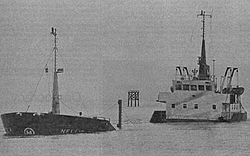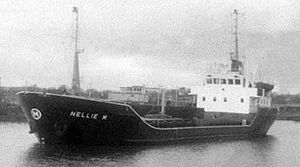Attacks on shipping in Lough Foyle (1981–82) facts for kids
Quick facts for kids Attacks on shipping in Lough Foyle |
|
|---|---|
 The coaster Nellie M after the bombing |
|
| Location | Lough Foyle |
| Date | 6 February 1981 23 February 1982 |
| Attack type | Ship hijacking, bombing |
| Weapon(s) | 2 pilot boats 4 explosive charges |
| Deaths | none |
| Injured | none |
| Perpetrator | Provisional Irish Republican Army |
The Provisional Irish Republican Army (IRA) carried out two bomb attacks. These attacks targeted British coal ships. They happened in February 1981 and February 1982. The location was Lough Foyle. This is a large water inlet between Northern Ireland and the Republic of Ireland. The IRA used hijacked pilot boats to get onto the ships. Both ships were sunk. However, their crews were safe and reached the shore in lifeboats.
Contents
Early Attacks on Ships
Before 1981, the IRA had attacked smaller boats. In April 1971, a Royal Navy survey boat was blown up. This happened at the port of Baltimore in the Republic of Ireland. The boat, called the Stork, was towed out to sea. It was then destroyed by an explosive device. Its crew was ashore. Another British boat, the Puffin, was slightly damaged in the same attack. Both boats were part of HMS Hecate'.
Between February and October 1972, the IRA bombed sand barges at Lough Neagh. Two IRA members died when one bomb exploded too early. In another incident, two barges were sunk. This caused a loss of £80,000. These barges were likely the Lough Neagh and the Ballyginniff.
On March 16, 1977, an IRA sniper shot at the Royal Navy patrol ship HMS Vigilant. This happened in Carlingford Lough. Royal Marines on board shot back. No one was hit on either side.
The killing of Lord Mountbatten happened on August 27, 1979. He and three others were on his fishing boat, the Shadow V. This took place at Mullaghmore.
Why the Attacks Happened
The IRA said their goal was to stop ships from going to and from Londonderry Port. This port is on the east side of Lough Foyle. They also wanted to force British and Irish authorities to put security guards on merchant ships. The IRA called these ships "commercial targets."
The British Royal Navy already had patrol boats in the area. These were the Bird class patrol boats, HMS Cygnet and HMS Kingfisher. Their job was to stop weapons from being smuggled from the Republic. The IRA often shot at these warships, especially from Carlingford Lough.
Sinking of the Nellie M
The Nellie M was a coaster ship. It weighed 782 BRT. It was built in 1972 in Yorkshire. At the time of the attack, it was owned by S. William Coe & Co. Ltd. of Liverpool. The attack happened on February 6, 1981. The ship was anchored close to the Republic's shore. It was waiting to go up the river. The coal ship had come from Liverpool with a cargo worth £1 million.
A group of 12 IRA men took over a pilot boat. They did this at a pier in Moville. Moville is on the northwest side of the inlet. Five of the group stayed on shore to watch. The other seven, carrying two bombs, made the pilot take them to the British coal ship. Once on board, they told the captain, Ian Eves, what they planned to do. They ordered him to gather his crew and get them into a lifeboat. Four IRA members watched the crew leave. At the same time, three others placed the bombs in the engine room.
The hijacked pilot boat then towed the lifeboat. It left the lifeboat floating near the eastern shore. The pilot boat then went back to Moville. As the lifeboat reached the beach, the first bomb exploded on the Nellie M. Huge flames could be seen for miles. They covered the ship's bridge. A second explosion happened hours later. This blew up parts of the ship, and it began to sink. The next morning, the back of the ship was underwater. The ship's hull was raised in 1982.
Sinking of the St. Bedan
The next year, the IRA did the same thing again. They attacked another British coal ship, the St. Bedan. This ship was going from Glasgow to Derry. The St. Bedan weighed 1,250 BRT. It was built in Clyde and launched in 1972. It was owned by J & A Gardner & Co. Ltd. of Glasgow. On February 23, 1982, the ship was anchored five nautical miles northeast of Derry. It was waiting for the tide to go upstream.
Again, 12 armed IRA members boarded the ship. The attack started from the pilot boat at Moville. The IRA group used the darkness and fog to their advantage. Once on deck, the IRA men told the second officer, David Hinson, and the captain, Roderick Black, to gather the crew on the bridge. The IRA members took "some photographs of us for American propaganda," according to Hinson. The ship's lifeboat with the crew was towed to the shoreline. This was done in the same way as with the Nellie M. After the bombs exploded, the cargo ship sank on its right side. It was in about 15 metres (49 ft) of water. The ship was later raised and taken apart for scrap by November 1982.
What Happened Next
One unexpected result of the bombings was a discussion in the Oireachtas (Irish Parliament). This was about who had legal control over the waterways in Northern Ireland. A company from the Republic of Ireland helped to salvage the Nellie M. Its wreckage was sold to a ship owner in that country. He fixed up the ship and renamed it Ellie. The coal ship was later bought by several companies. It was made longer by 7 metres (23 ft) and renamed Trimix. In the 2000s, a Colombian company managed it after it was renamed Dove. The St. Bedan was too damaged to be fixed. It was taken apart for scrap in Liverpool.
The Royal Navy and the Royal Air Force increased their patrols in Northern Ireland waters after these attacks.
The IRA hit a bigger naval target in 1990. Some of its members got onto RFA Fort Victoria. This ship was anchored near Belfast shortly after it was launched. They placed two large bombs in its engine room. One bomb exploded, causing a lot of damage. The second bomb was safely removed.
One of the IRA sniper teams shot at HMS Cygnet in December 1993. This happened at Carlingford Lough. They used a Barret .50 calibre rifle. No hits were made.
Lough Foyle was again attacked by the IRA on May 23, 1994. An IRA unit stole a motor boat. They used it to place a bomb at the jetty of the Fort George British Army base in Derry. Two soldiers were hurt. One of them became permanently blind from the explosion.
See Also



